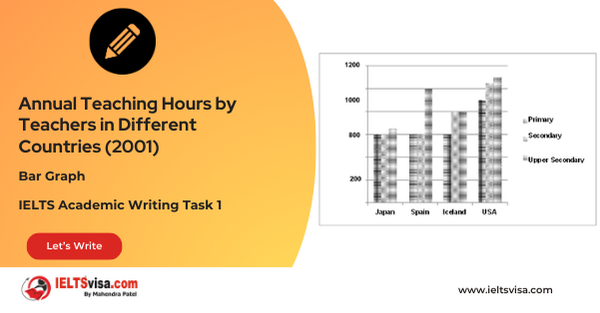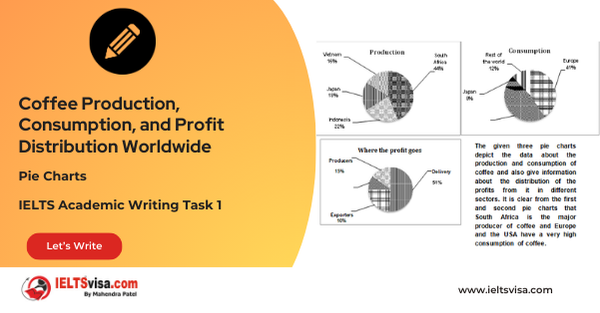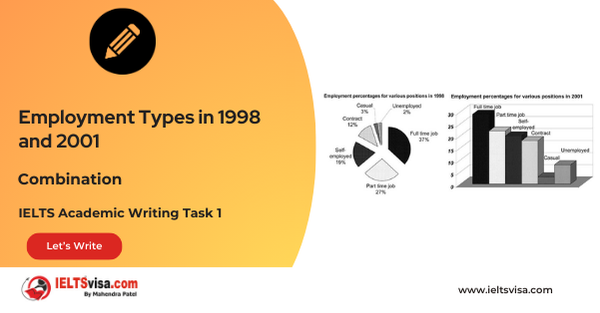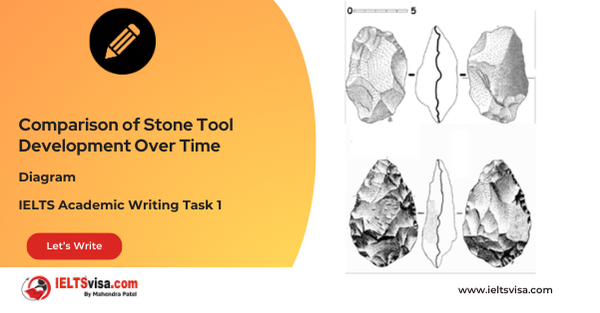The plan of Walton Museum in 2008 and the plan in 2012, after it was redeveloped
IELTS Academic Writing Task 1 - Map
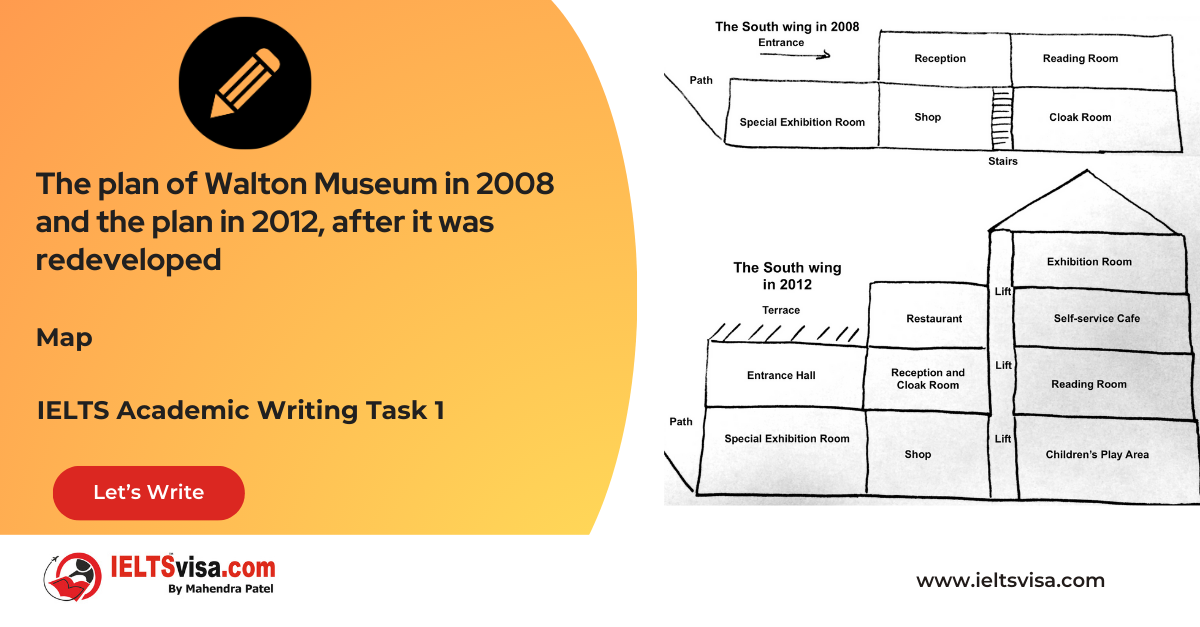
IELTS Writing Task 1 Question
The pictures below show the plan of Walton Museum in 2008 and the plan in 2012, after it was redeveloped. Summarise the information by selecting and reporting the main features and make comparisons where relevant.
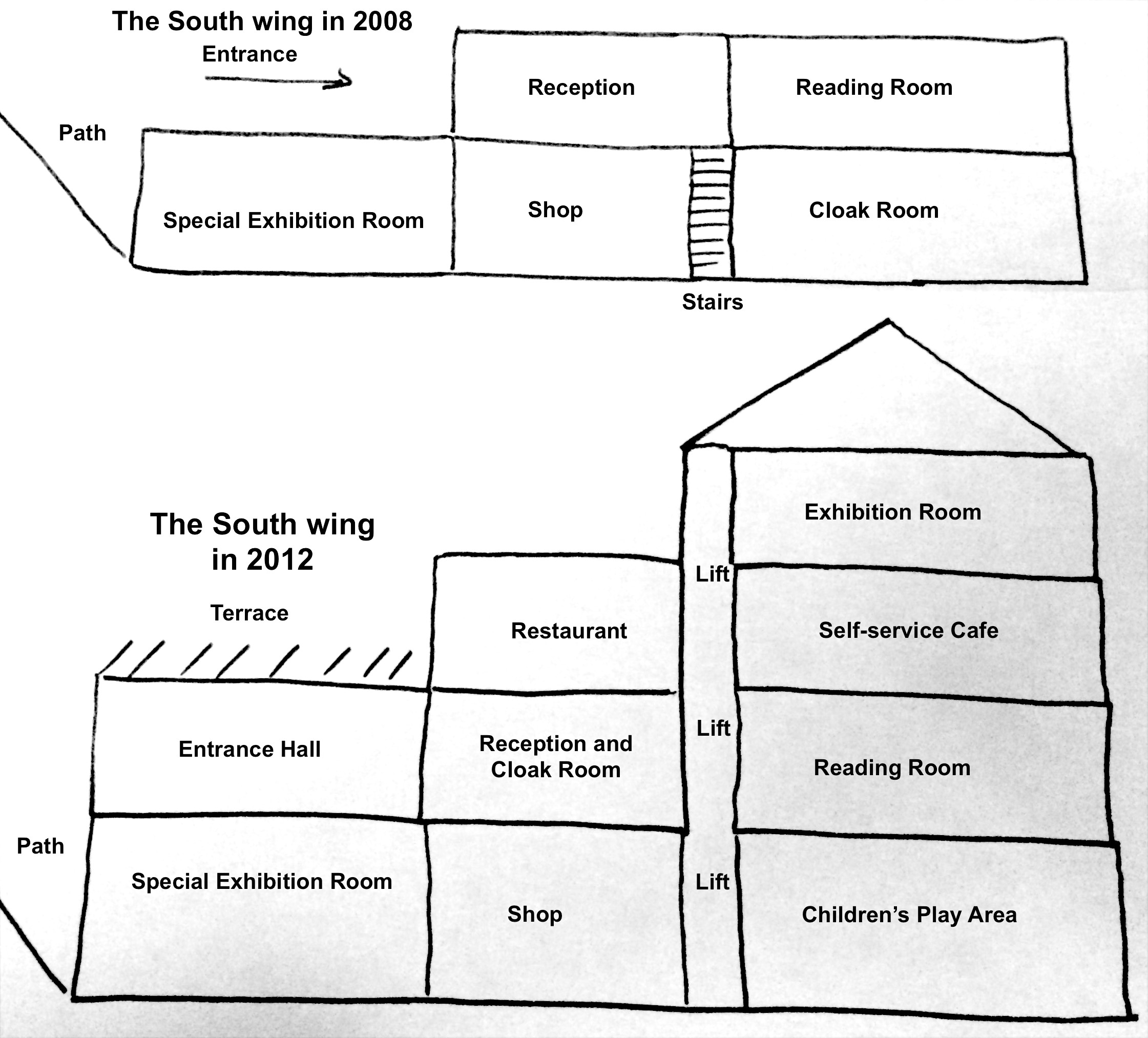
Common Questions for the Maps/Diagram
1. Graph Type: Map/Diagram
2. Title: Redevelopment of Walton Museum from 2008 to 2012
3. What are the units of measurement?: Not applicable
4. Who: Walton Museum
5. When: 2008 and 2012
6. Where: Walton Museum
7. Topic: Structural changes in the Walton Museum over a four-year period Comparison Showing and Trends
Comparison Showing and Trends Any change over time (such as an increase or a decrease) is a trend.
Comparison 1 : Walton Museum in 2008
- Details:
1. South Wing Structure: Two storeys with a west-side path.
2. First Floor: Special exhibition room, shop, and cloak room.
3. Second Floor: Entrance, reception, and reading room.
4. Stairs: Between the shop and cloak room.
Comparison 2 : Changes by 2012
- Details
1, Expansion: Four storeys with a lift.
2. New Facilities: Children’s play area, self-service café, and restaurant.
3. Entrance Hall and Terrace: Constructed above the special exhibition room.
4. Relocated Cloak Room: Moved to the reception area.
Sample Answer
The maps illustrate the structural changes made to Walton Museum between 2008 and 2012. It is evident that the museum underwent significant redevelopment during this four-year period.
In 2008, the South Wing of the museum consisted of two storeys. The first floor included a special exhibition room, a shop, and a cloakroom, with stairs positioned between the shop and the cloakroom. The entrance and reception were on the second floor, adjacent to a reading room. A path ran along the west side of the building.
By 2012, the museum had expanded to four storeys and a lift was installed to facilitate movement between floors. The cloakroom was relocated to the reception area, and a children’s play area was introduced in its former space. The second floor saw the addition of a self-service café on the eastern side, above the reading room, while a restaurant was constructed on the western side, above the reception and cloakroom. The topmost floor included a new exhibition room above the café, and an entrance hall was built above the special exhibition room, topped with a terrace.
Overall, the redevelopment of the Walton Museum brought significant structural changes, with the exception of the special exhibition room and the shop, which remained unchanged.
Top 27 Vocabulary
| Vocabulary (type) | Meaning | Synonyms | Examples |
| Redevelopment (noun) | The process of developing something again | Renovation, overhaul | “The redevelopment included a new café.” |
| Adjacent (adj) | Next to or adjoining something | Next to, beside | “The reception was adjacent to the room.” |
| Facilitate (verb) | To make an action easier | Enable, assist | “A lift was added to facilitate access.” |
| Expansion (noun) | The action of becoming larger | Growth, extension | “The museum saw an expansion in 2012.” |
| Structural (adj) | Relating to or forming part of a structure | Constructional, architectural | “The structural changes were major.” |
|
Illustrate (verb) |
To explain or show something using visuals or examples |
Depict, demonstrate |
“The maps illustrate the changes made to Walton Museum.” |
|
Transformation (noun) |
A thorough or dramatic change in form or appearance |
Change, overhaul |
“The museum underwent significant transformation.” |
|
Exhibition (noun) |
A public display of items or works |
Display, showcase |
“The special exhibition room remained unchanged.” |
|
Relocate (verb) |
To move something to a different place |
Move, transfer |
“The cloakroom was relocated to the reception area.” |
|
Introduce (verb) |
To bring something new into use |
Implement, add |
“A children’s play area was introduced in 2012.” |
|
Expansion (noun) |
The process of increasing in size or scope |
Growth, enlargement |
“The museum underwent an expansion to include four storeys.” |
|
Facilitate (verb) |
To make a process or activity easier |
Assist, ease |
“A lift was installed to facilitate movement between floors.” |
|
Renovation (noun) |
The act of improving or modernizing a building or space |
Restoration, remodeling |
“The renovation included a self-service café and a restaurant.” |
|
Relocation (noun) |
The act of moving to a new place |
Transfer, shift |
“The relocation of the cloakroom allowed for new facilities.” |
|
Adjoining (adj) |
Sharing a common boundary or wall |
Adjacent, neighboring |
“The café was located in the adjoining area above the reading room.” |
|
Terrace (noun) |
A flat area on the top or side of a building |
Balcony, deck |
“A terrace was added to the topmost floor of the museum.” |
|
Unchanged (adj) |
Remaining the same as before |
Constant, unaltered |
“The shop and the special exhibition room remained unchanged.” |
|
Structure (noun) |
The arrangement or organization of something |
Building, framework |
“The new structure included a lift and additional floors.” |
|
Reception (noun) |
A designated area for receiving visitors |
Lobby, foyer |
“The cloakroom was relocated to the reception area.” |
|
Self-service (adj) |
A system where customers serve themselves |
DIY, automated |
“A self-service café was added on the second floor.” |
|
Addition (noun) |
Something new that is included |
Inclusion, supplement |
“The addition of a restaurant enhanced the museum’s facilities.” |
|
Introduce (verb) |
To make something available for the first time |
Implement, launch |
“A children’s play area was introduced in the former cloakroom space.” |
|
Adjacent (adj) |
Close to or near something |
Next to, beside |
“The reception was adjacent to the reading room.” |
|
Construct (verb) |
To build or form by putting together parts |
Build, create |
“A restaurant was constructed on the western side of the museum.” |
|
Facility (noun) |
A place, feature, or service provided for a specific purpose |
Amenity, infrastructure |
“The lift was a facility added to improve accessibility.” |
|
Floor (noun) |
A level or storey of a building |
Storey, level |
“The museum expanded from two to four floors.” |
|
Expand (verb) |
To increase in size, scope, or capacity |
Enlarge, extend |
“The museum expanded vertically to accommodate new facilities.” |

Our Books
Master IELTS Speaking Part 1
IELTS Writing Task 1 Book
IELTS Writing Task 2 Book
Writing Task 1 Question Types
Practice IELTS Other Modules
IELTS Listening
The IELTS Listening test assesses how well you can understand spoken English in various contexts. It lasts about 30 minutes and is divided into four sections with a total of 40 questions. The listening tasks become increasingly difficult as the test progresses.
IELTS Academic Reading
The IELTS Academic Reading section assesses your ability to understand and interpret a variety of texts in academic settings. It is designed to evaluate a range of reading skills, including skimming for gist, reading for main ideas, reading for detail, understanding inferences, and recognizing a writer's opinions and arguments.
IELTS Speaking
The IELTS Speaking test assesses your ability to communicate in English on everyday topics. It lasts 11-14 minutes and consists of three parts: introduction, cue card, and a discussion based on the cue card topic.
IELTS General Reading
IELTS General Reading tests your ability to understand and interpret various types of texts. Here are some key areas and types of content you can expect to encounter in the reading section, along with tips for effective preparation.
IELTS Academic Writing Task 1
In IELTS Academic Writing Task 1, you are presented with a visual representation of information, such as graphs, charts, tables, or diagrams, and you are required to summarize, compare, or explain the data in your own words.
IELTS General Writing Task 1
In IELTS General Writing Task 1, you are required to write a letter based on a given situation. The letter can be formal, semi-formal, or informal, depending on the prompt. Here’s a breakdown of the key components to include in your letter
IELTS Academic Writing Task 2
In IELTS Academic Writing Task 2, you are required to write an essay in response to a question or topic. Here’s a guide to help you understand the essential elements of this task
IELTS Exam Tips
To succeed in the IELTS exam, practice regularly, familiarize yourself with the test format, improve your vocabulary, develop time management skills, and take mock tests to build confidence.
Grammer for IELTS
Grammar is the foundation of effective communication in English. Understanding tense usage, subject-verb agreement, and sentence structure enhances clarity and coherence in writing and speaking.
Vocabulary for IELTS
Vocabulary plays a crucial role in the IELTS (International English Language Testing System) exam, especially in the Speaking and Writing sections. Here’s an overview of why vocabulary is important and how it impacts your performance
RECENT IELTS SAMPLES QUESTIONS AND ANSWERS
Task 1 – Column graph – Percentage of Young People Enrolled in Universities in 2000 and 2007.
20:00 Start Pause Stop [df_adh_heading title_infix="IELTS Writing Task 1 Question" use_divider="on"...
Task 1 – Bar Graph – Annual Teaching Hours by Teachers in Different Countries (2001)
20:00 Start Pause Stop [df_adh_heading title_infix="IELTS Writing Task 1 Question" use_divider="on"...
Task 1 – Pie Charts – Coffee Production, Consumption, and Profit Distribution Worldwide
20:00 Start Pause Stop [df_adh_heading title_infix="IELTS Writing Task 1 Question" use_divider="on"...
Task 1 – Column graph – Types of Transport Used by Tourists Visiting New Zealand from Five Countries in 2004.
20:00 Start Pause Stop [df_adh_heading title_infix="IELTS Writing Task 1 Question" use_divider="on"...
Task 1 – Bar and Pie Chart Combination – Employment Types in 1998 and 2001
20:00 Start Pause Stop [df_adh_heading title_infix="IELTS Writing Task 1 Question" use_divider="on"...
Task 1 – Diagram – Comparison of Stone Tool Development Over Time
20:00 Start Pause Stop [df_adh_heading title_infix="IELTS Writing Task 1 Question" use_divider="on"...


